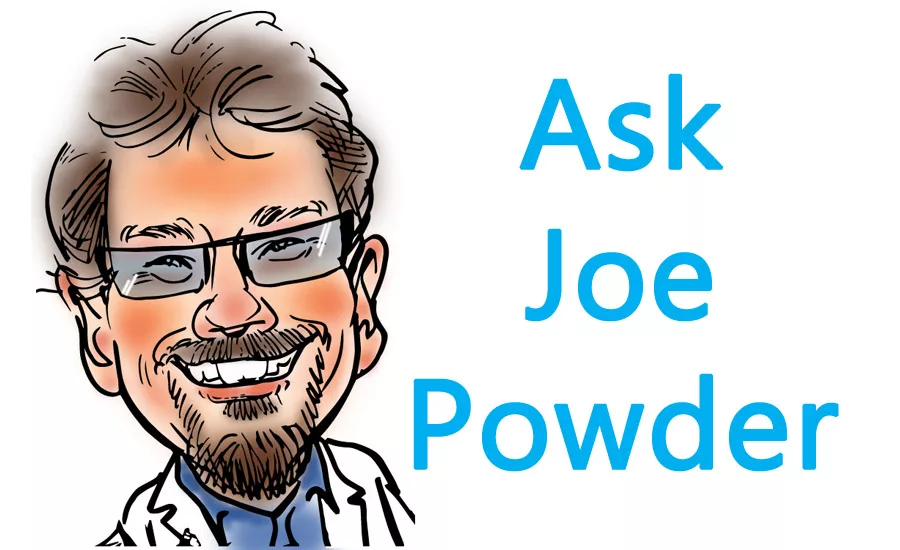Ask Joe Powder: What is the Best Way to Degrease Steel and Aluminum Prior to Coating?

Our popular Ask Joe Powder blog has made its way to the pages of PCI magazine. What are your powder coating questions and challenges? Joe Powder, aka Kevin Biller of ChemQuest Powder Coating Research, shares his powder coating knowledge and expertise by answering questions sent in from around the world.
Dear Mr. Powder,
What do you think is the best way to degrease steel and aluminum prior to coating? I have seen various options out there, but it seems there are so many to choose from, and I was wondering what you thought is the best option. Specifically, when media blasting is not an option due to the "coarse" surface area left. I know media blasting works, but it is still difficult to get a smooth surface.
Thanks in advance,
Jeff Arbuckle
Rangiora, New Zealand
Hi Jeff,
Thank you for your questions. Here is the lowdown on preparing metal for powder coating.
First the durability requirements of the finish must be carefully considered. If this is a basic indoor application that won't see much wear and tear or moisture, heat, etc., then simple solvent cleaning and, possibly, media blasting will suffice. For anything that will reside outdoors you need more than that.
Powder chemistry has a significant influence on durability and performance. For instance, epoxies and hybrids adhere well over blasted metal and can provide decent corrosion resistance with a minimum of surface preparation. Essentially, all other chemistries require metal cleaning followed by chemical pretreatment. So, if you are using a polyester, acrylic, or polyurethane powder it's best to clean the metal first with an alkaline solution, rinse well, then apply a chemical pre-treatment. These are typically phosphate based for steel and chromate based for aluminium. Chromate is rather hazardous (actually carcinogenic), so I would strongly recommend that you investigate alternate materials if you need to pre-treat aluminium.
Newer, non-chromate metal pre-treatment types based on zirconates, titanates, and silanes have replaced chromate in many finishing systems. These are essentially non-toxic. Process control with these is critical, and therefore it is necessary to carefully follow the supplier's application parameters.
It is also very important to recognize that although cleaning techniques may be universally acceptable for both steel and aluminium, chemical pre-treatments do not translate across these very different metals. Iron phosphate works well on ferrous substrates, however, it does not prepare aluminum adequately for high-performance powder coating performance. You will need chemistry specific to your metal type.
Best regards,
Mr. Joe Powder
Hello Joe,
Is moisture an important measurement in the manufacturing of powders used in coating? If so, how is water measured? Also, does water affect a polyurethane powder-coating-curing mechanism?
Geoffrey Brown
Pullman, Washington
Hi Geoffrey,
Believe it or not, powder coatings can tolerate a fair amount of moisture – up to 0.5% or more. As a matter of fact, completely dry powders in a very-low-humidity environment (< 15% RH) exhibit electrostatic charging problems. Think of the charge picked up by dragging your feet (with socks) across carpeting, on a very-dry day in cold winter. Excess static charge abounds. Therefore, a little bit of moisture is better than none. Nevertheless, high levels of moisture (>1.0%) can cause clumping issues and poor fluidization. These phenomena create handling and application problems.
As for moisture interfering with cure in an isocyanate-cured polyester powder – this is not an issue because there is negligible free NCO available because a blocking agent is present.
Best regards,
Joe Powder
Dear Joe,
Waterjet metal cutting uses silica sand (silicon dioxide SiO2). Will this type of silicon cause adhesion problems and fisheye craters? I have adhesion problems around the edges of steel that have been cut this way. The flat areas are fine, and there are no issues with cure and adhesion, just the edges. The steel cut edges are 10 mm thick and peeling off. The metal was washed with hot iron-phosphate water solution and rinsed, dried, and primed before the topcoat! It was not rusty and came from the waterjet cutter clean and rust free, and was powder coated the same day.
Sincerely,
David Beaver
East Liverpool, Ohio
Hi David,
Thank you for your question regarding abrasive waterjet cutting and its effect on the surface of metal. It requires a bit of research to understand what is causing the adhesive failures and fisheyes in your powder coating. On the surface (pun intended) what could be a problem? Water shouldn't cause an issue with adhesion or cratering. In addition, silicon dioxide is inert and is not known to cause fisheyes or craters. And you report that the surface is not corroded when you apply the powder coatings.
Here's where I would look for the root cause and, hopefully, the eventual solution: dispersion of the SiO2 in the water probably requires the use of a surfactant, otherwise the silicon dioxide would not mix well into the water and the process would be ineffective. In addition, the use of a surfactant to disperse the abrasive may require a defoamer to minimize foaming. Surfactants and defoamers are known to cause adhesion and cratering issues in powder coatings. The use of a high-pressure stream of abrasive slurry would only exacerbate the problem by embedding the surfactant/defoamer into the steel surface.
I would guess that the surfactant cannot be eliminated from the slurry. Perhaps there is an alternate surfactant that doesn't cause this problem, but I would not expect this to be the case. Consequently, you will need to identify a method that can aggressively remove residual surfactant on the machined edges. Two paths are possible:
- Use mechanical means to abrade the edges (sanding, grinding, etc.).
- Use a strong acid to etch the edges.
The mechanical approach is either labor intensive or costly to automate. The chemical approach is expensive and requires the handling of potentially hazardous materials. There are no easy answers here. Alternately, you can consider using a different cutting technique, but you're probably also aware that laser cutting can cause similar adhesive failures for a different reason.
Good luck digging around for a solution. Let me know if you have any other ideas or questions.
Best regards,
Joe
Do you have a question for Joe Powder? Email kbiller@chemquest.com. And be sure to listen to the Ask Joe Powder “Powdcast” for all the latest news, insights and technology in the powder coatings industry. Click here to listen!
Looking for a reprint of this article?
From high-res PDFs to custom plaques, order your copy today!






